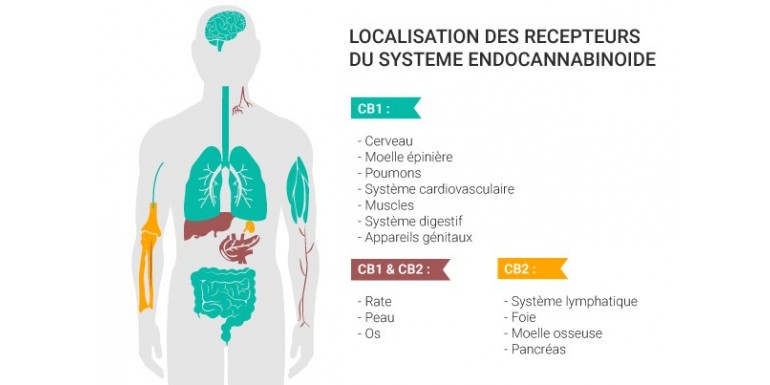
The endocannabinoide system
The term "cannabinoid" means any chemical that can bind to the receptors of the human body that constitute the endocannabinoid system. There are three types: endogenous cannabinoids, phytocannabinoids and synthetic cannabinoids. The first are naturally present in the body, the latter are naturally present in plants, especially in hemp but not only, and the third are synthetic molecules created in the laboratory.
Cannabinoids" to the endocannabinoid system
Originally, the term "cannabinoid" was used to designate certain chemical components of hemp, including THC, which was first isolated and synthesized by Israeli professor Raphael Mechoulam in 1964. In the 1980s, the U.S. government completed studies to try to understand the effect of THC on the brain. It is on this occasion that American scientists Allyn Howlett and William Devane discover specific receptors - consequently called cannabinoid receptors - to which the THC molecule is linked and through which it acts.
Israeli doctors Lumir Hanus and Raphael Mechoulam and American researcher Willian Devane have deduced from this discovery the existence of molecules similar to THC in the body. In 1992, they discovered the first cannabinoid called endogenous: anandamide. The study of endogenous and exogenous cannabinoids then led to the discovery of a whole molecular reporting system involved in regulating a wide range of biological functions: the endocannabinoid system.
Endogenous cannabinoid system
The endocannabinoid system consists of cannabinoid receptors and their natural binders (endocannabinoids). It also includes enzymes responsible for metabolization and degradation of endocannabinoids in the body. It is involved in body homeostasis which is the process by which the body maintains an internal balance despite external variations. In other words, he is a regulator.
When an imbalance is detected by the organism, it produces specific endocannabinoids which function to activate the cannabinoid receptors placed on the cell surface. Through receptors, the detection of imbalance is communicated to cells that adapt their amemen. The activation of the receptors can lead to the modification of the cell physiology, its motility, its synaptic functioning and its gene transcription; it stimulates a chemical reaction that brings the physiological process back to the holistic equilibrium.
This biochemical reporting mechanism plays a role in many essential functions of the human body such as appetite regulation, digestion, pain, energy, sleep, motor functions, reproductive functions, pleasure or regulation of body temperature.
The main cannabinoid receptors are CB1 and CB2. The first are mostly present in the brain, at the central nervous system. The latter are rather associated with the immune system and concentrate in organs such as the intestine, spleen or liver. These are CB1 and CB2 receptors everywhere in the body.
Concerning endocannabinoids, the most studied and bioactive are anandamide (arachidonyl ethanolamide); AEA) and 2-arachidonoylglycerol (2-AG). However, there are many others. There are also other receptors that interact with cannabinoids (CB3 receptors, vanilloid receptors, TRP channels, PPAR etc.).
Below, the location of the receivers of the endocannabinoide system, via the site of the professeur-cbd.com
Hemp and canabinoides
The hemp contains more than a hundred cannabinoids already identified. They are produced by trichomes, these resinous glands that cover the flowers and some leaves from the plant to the mature state. They are present in variable quantities depending on the degree of maturation of the plant, the conditions of cultivation and the variety of hemp. Typically, hemp is distinguished from "cannabis" by its low THC rate (
For now, the attention of scientists is focused on THC and CBD, which are the most abundant and best known cannabinoids. However, there are many others: THCA, CBDA, CBDV, CBG, CBN, THCV etc. When hemp is consumed, phytocannabinoids interact with endocannabinoid receptors. If they cause a receptor to act the same way as an endogenous molecule, they are called agonist. If they interfere with the interaction of a receptor with an endogenous molecule, they are said to be antagonistic.
The discovery of the endocannabinoid system is recent and its operation is still poorly known, but it is already known that a deficiency of this system (indocannabinoid clinical defect) can cause various disorders. Therefore, the interaction of phytocannabinoids with cannabinoid receptors has become a central concern for research. Intake of exogenous cannabinoids could overcome a lack of endocannabinoid production or simply stimulate the system. Cannabinoid-based drugs (phyto- or synthetic) already exist to treat plate sclerosis and epilepsy.

